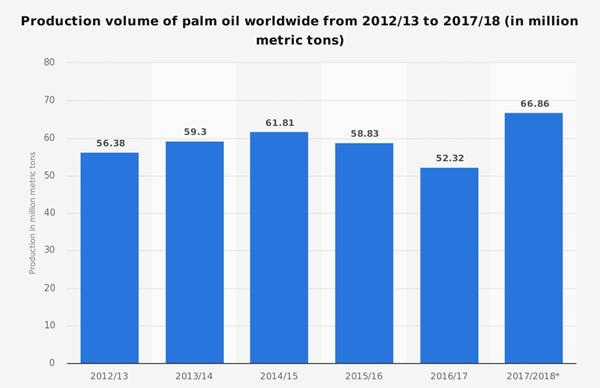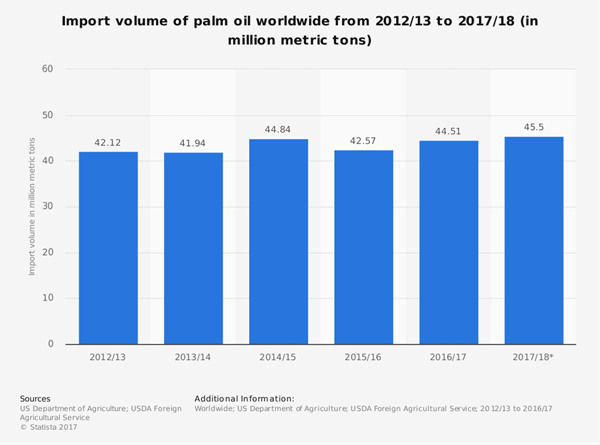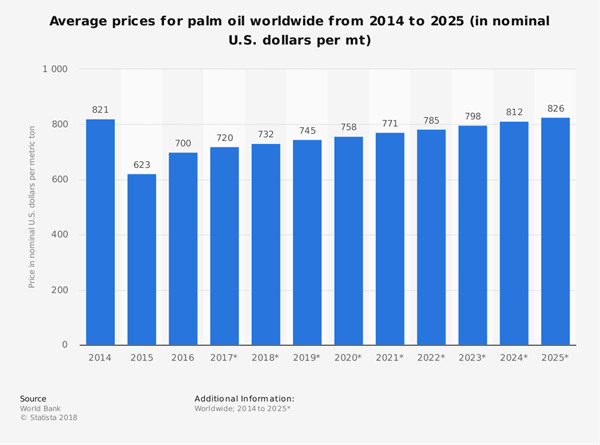Nigerian Palm Oil Industry Statistics, Trends & Analysis
One of the most important economic activities to take place in Nigeria is the processing of palm fruit. These fruits create palm kernel oil and palm oil. There are about 70,000 square miles that provide excellent growing conditions for wild palm oil, called the “Palm Belt.” Most of this area is located in southern Nigeria.
Taking palms out of the wild and onto plantations has expedited the growth of the industry. It can take up to 15 years for the palm to rise above the underbrush to begin bearing fruit when it grows out in the wild. When planted for plantation growth, fruit can be produced in as little as four years.
At the same time, the difference in oil production from a plantation-grown palm to one that grows in the wild is a 5:1 ratio. That is why this industry is thriving today, but there are also challenges that must be met along the way.
Important Nigerian Palm Oil Industry Statistics
1. Palm oil consumption in Nigeria has been relatively consistent since 2011-2012. About 1.405 thousand metric tons are consumed each year.
2. In 2015, mature lands made up about 95% of the total land area.

Global palm oil industry statistics
3.Sales growth forecasts for the Nigerian palm oil industry are up to 40% for the coming year, with PBT growth estimates as high as 62.7%.
4. There is an estimated supply gap of up to 500,000 metric tons that the palm oil industry in Nigeria could tap into for additional revenue opportunities.
5. Palm oil and palm kernels traditionally compose up to 20% of Nigeria’s total exports.
6. Domestic production of palm oil in Nigeria is at nearly 900,000 tons.
7. There is a 30% mark-up for TPO and a 17% mark-up for bulk SPO and TPO. Palm fruit that is being delivered for SPO must be completed within 12 hours of the fruit being harvested.
8. Domestic pricing for palm oil is almost on the import parity price for the product, which includes a duty of 35%.
9. The nine states that are found within the Niger Delta account for nearly 60% of the total production values for the Nigerian palm oil industry.
10. What has plagued the industry has been an inefficiency with its processing technology. On any given harvest, up to 50% of the oil that is possible from the palm fruits is lost.

Global palm oil industry statistics
11. The traditional market for palm oil is usually served by small-scale palm oil mill plant in the industry. These producers account for more than 70% of local production needs, or about 650,000 tons in total.
12. After rising production and demand from 1964-2010, demand has begun to grow faster than supplies. In total, the global palm market may be short 150,000 metric tons every year.
13. Although it is still a major contributor to the palm oil industry worldwide, Nigeria is no longer the world’s top producer. Both Indonesia and Malaysia produce more palm oil than Nigeria does today.
14. For the domestic market, TPO is the primary driver for food oil consumption. It accounts for about 80% of the total production of palm oil in Nigeria.
15. Palm oil is ranged as one of the four worst global industries for forced labor by the U.S. government., including child labor.
16. The saturated fat levels of palm oil are quite high. Just one tablespoon of it contains up to 55% of the daily recommended levels of saturated fat. Because of this, there are suspected links to heart and cardiovascular disease to the consumption of palm oil.
17. Palm oil is a highly versatile product. It’s chain of production includes cosmetics, candles, and biofuels, in addition to food products.
18. About 300 yards of rainforest are cleared each hour to create increased levels of palm oil production. That is why the Nigerian industry is poised for a strong comeback, since the palm is indigenous to that region.
19. Every palm tree requires a 10-foot diameter to be clear, so the tree can grow properly.
20. Despite the influences of Nigeria on the palm oil industry, Indonesia and Malaysia account for 90% of the global market supply.

Global palm oil industry statistics
21. What makes palm oil such a popular product is the amount of oil that can be produced from a single harvest. When compared to sunflower seeds or soybeans, palm fruit can produce up to 10 times more oil.
22. At the beginning of the 20th century, about 250,000 tons of palm oil competed with the Nigerian market for global attention. Now more than 60 million tons of palm oil comes from Southeast Asia, leaving most of the Nigerian production to be reserved for domestic consumption.
23. Global palm oil prices have risen significantly, with the current price premium about 45% over the international price of $1,042mt. Despite the higher prices, the Nigeria palm oil industry is not competitive because it has little coordination with its major suppliers and has generally low levels of productivity.
Nigerian Palm Oil Industry Trends and Analysis
Up until the 1960s, Nigeria controlled more than 40% of the world’s palm oil needs. Because of over-tapping and a reliance on traditional methods, the industry’s share of the market has continued to fall since then. It has now gotten to the point where more than 500,000 tons of palm oil must be imported just to satisfy domestic demand.
Several companies are leading the way in trying to expand the palm oil industry. Since 2001, bulk crude and refined vegetable oils have been prohibited from entry in Nigeria. That has created new plantations and expanded existing operations, but it has also encouraged overgrowth.
With the establishment of agricultural development programs and innovative farming practices, there is no doubt that that palm oil industry in Nigeria will survive. How it will thrive is the next question that must be answered.